
An Cheathrú Rua agus na hOileáin sa Naoú hAois Déag|Áine Ní Chonghaile|Cló Iar-Chonnacht| ISBN 978-1-78444-220-0|€20
“Áine Ní Chonghaile presents us with a rich and intricate weave of people, places and events in a scholarly and readable overview.”
by Cathal Póirtéir
This study of south Connemara in the nineteenth century is local history at its best, combing high academic standards with in-depth local knowledge.
This is no surprise as the author, Áine Ní Chonghaile, is a native of the area in question and the book is based on her doctoral thesis in history.
She has examined all the relevant printed primary and secondary sources dealing with the area in that period, as well as drawing on the rich oral traditions of the area that recall and reflect on what happened to the local community during the century in question.
Rich source of information
Not surprisingly the second half of the century is a richer source of information than the less well served pre-famine period, and the wonderful work of the Irish Folklore Commission is a resource that the author augments with her own local knowledge and fieldwork.
The area was and is a Gaeltacht and the strength of the oral tradition and the publication of local histories and memoirs in Irish in the early twentieth century have left an important historical legacy here.
Serious work of research
Many readers will know the general area of An Cheathrú Rua as a destination for summer holidays or Gaeltacht summer courses, and may have fallen in love with the exceptional beauty of Leitir Mór, Leitir Meallain and Garmna on a sightseeing drive.
Curious readers, however they come to this book, will find a mine of information here that goes far beyond being a guide for visitors, tracing the many changes that happened among landlords and tenants during the century that witnessed the Great Famine and its aftermath.
This is a serious work of research and even knowledgeable local readers will learn a great deal from An Cheathrú Rua agus na hOileáin sa Naoú hAois Déag.
This study is full of telling detail that fills out and enriches what we know of the history on this part of the Connemara coast.
The story the author tells is complemented by well-chosen photographs, maps and tables that bring their own focus to the overall narrative.

Social and economic change
The hundred years in question saw a lot of social and economic change in Ireland, Connemara included, as communications improved, land ownership and settlement patterns changed, state intervention became more widespread, the first Ordnance Survey was carried out and the influence of the Catholic church grew.
The results of famine and emigration affected local communities deeply as well as influencing national politics and economics. Catholic Emancipation and the Land League transformed politics and nationalist sentiment and organisations grew.
Ownership and use of land
How the ownership and use of land changed here is central to the story. The older traditional landlords and gentry, like the O’Flahertys and Martins, were gradually replaced as fortunes changed and new owners from outside bought up estates, some of them in turn being replaced by corporate investors like the Law Life Insurance Company.
Nevertheless the Kirwins and Saint Georges seem to have been successful in holding onto their estates for longer than most.
As well as changes in landlords and the replacement of the traditional communal rundale system by newer farming and settlement patters, new tenants arrived as well, as witnessed by new surnames arriving alongside the old.
Economic survival
Farming, fishing, kelp making, turf cutting and smuggling were often combined in various measures as means of economic survival.
Where the quality of the land was poor and challenging, people were forced to find other ways to make a living and trade, particularly a community that was on the margins of state interest.
Gradually however, the state played a more important role as education, policing, poor houses and relief measures became important from famine times on. The later work of the Congested Districts Board had a long lasting effect on this and many other areas of the west.
Rich and intricate
Gradually leaders in local communities and members of the clergy took on roles as spokespeople and engaged with the authorities, sometimes opposing them when evictions were threatened or carried out, notably the trouble in An Cheathrú Rua in 1880.
Readers will not lack in details to pick over in this account of the changes in a Gaeltacht community over the nineteenth century which helped shape the landscape and economy of the area today.
Áine Ní Chonghaile presents us with a rich and intricate weave of people, places and events in a scholarly and readable overview that deserves a readership much wider than the area it examines.
Previously in Leabhair Idir Lámha by Cathal Póirtéir


Cathal Póirtéir has specialised in researching, presenting and commissioning Irish interest material in various radio formats and in books, including history, literature and folklore in Irish and English, as well as current affairs and drama.











